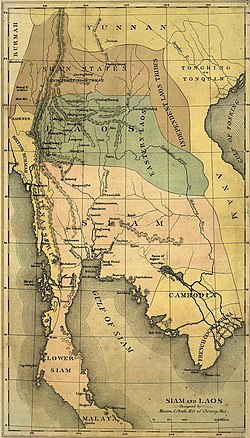Chiang Hung
| Chiang Hung State Keng Hung |
|||||
| State of the Shan States under the suzerainty of China | |||||
|
|||||
| Chiang Hung (Chiang Hoong) on a 19th century map including the Chinese Shan States | |||||
| History | |||||
| • | Chiang Hung state established | 1180 | |||
| • | Annexed by China | 1892 | |||
| Today part of | Xishuangbanna Dai Autonomous Prefecture, China | ||||
Chiang Hung or Keng Hung (Thai: เมืองหอคำเชียงรุ่ง; Mueang Ho Kham Chiang Rung) was one of the states of Shans under the suzerainty of China.
Chiang Hung was inhabited mainly by Tai Lü people, a branch of the Shans or Tai. Its capital was the city of Chiang Hung, modern Jinghong. The kingdom, in its most powerful state in the 13th century, covered a large area before being overwhelmed by neighboring powers such as the Yuan dynasty, the Lanna kingdom, and the Burmese Empire. Chinese dynasties recognized the local leaders as tusi of Cheli (Chinese: 車里宣慰使).
The history of the state can be divided in two periods:
Phanya Coeng, Paya Jueang (Thai: พญาเจื่อง) or Chao Jueang Han (Thai: เจ้าเจื่องหาญ) was said to wage wars with the native Akha and other Tai peoples in the area and established the kingdom in favor of Tai Lü people at Chiang Hung or Heo Kam on the Mekong in 1180. In the early 13th century, King Inmueng greatly expanded Heokam territories. The tributaries of Heokam kingdom includes Kengtung, Ngoenyang, Meuang Thaeng (modern Dien Bien Phu – the capital of Tai Dam people), and Xieng Thong (Luang Prabang), making Heokam the sole leader of Tai kingdoms in the north. The Tai Lü people then began scattering throughout Heokam’s area of influence.
...
Wikipedia

